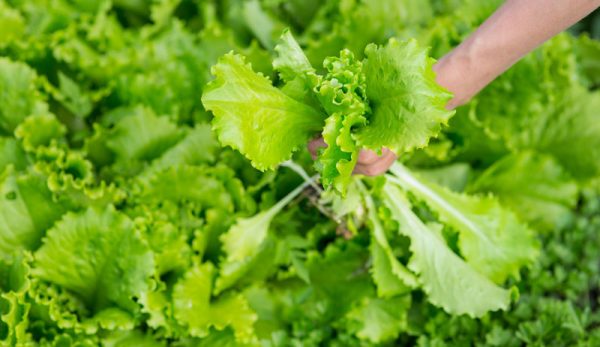
There is good profit to be made by growing lettuce mixes for salad greens—especially if there is higher yield from a piece of ground. In early spring the potential to cut greens and have them grow again for a repeat harvest is good. But this process does require some care and understanding to ensure the quality and quantity stays high.
Growers need to consider varieties, planting and harvest techniques, and overall soil quality.
Also read – 6 Lettuce Varieties Perfect For The Fall Garden
The Basics of Cut-and-Come Growing
Cut-and-come refers to growing lettuce to a good size for harvest, then cutting, washing, bagging and selling the product as a salad mix. The lettuce is then allowed to regrow so another harvest can be had.
If you yield is one bag per bed foot, for instance, then allowing the lettuce to regrow will provide two bags per bed foot. A third harvest could yield yet another bag. This increases the return on space, seed and planting cost, and time as growing from seed takes longer than regenerating from a cut plant.
Read more: Grow lettuce through summer heat (without bolting) with these 6 tips.
Tips for Cut-and-Come Lettuce
Here are some pro tips for this type of lettuce production.
1. Don’t grow the lettuces mixed within the row.
If you want a colorful mix of different lettuces or to add other types of greens into the mix (like arugula or baby kales), these should be grown in separate blocks within the bed, in separate rows or even within separate beds.
This is because different varieties have different grow habits and days to maturity, which may interfere with easy production.
For instance, some varieties of lettuce may bolt (go to seed) quicker than others. If mixed, they will hamper harvest of varieties with a longer period of time to bolting. Additionally, greens like arugula require different pest management techniques than lettuces.
2. Make sure to seed your rows straight and have the correct seeds per row foot for the variety and the size at which you will harvest the greens.
Most cut-and-come greens are harvested larger than baby salad. Not all markets want this, of course. But if you establish yourself with a high quality and affordable salad mix at a larger size (4-8 inch leaves), you will get many pounds of greens out of a bed, with less overall seed used and more ability for cut-and-come harvesting.
This is because the larger plant regenerate easily.
3. This method is best practiced in spring when weather is mild, moisture is high and the pressure on the lettuce to bolt is low (less extreme heat).
Keep your plantings moist with a sprinkler for germination and to help regeneration if rain is not available for a period.
4. You can readily get two to four cuts from a single bed in the right conditions.
Maximize your harvest!
5. Choose varieties of lettuce that don’t bolt easily.
This is especially important if growing in a drier/hotter climate.
6. My preference is salad bowl oakleaf lettuces.
This variety doesn’t have uniform leaf shapes, so even leaves at the center of the plant whose tip is cut off can regrow and look nice. A romaine lettuce that is left to regrow will have some inner leaves that are cut at the top and look less attractive.
7. When you harvest, keep the bed clean.
Don’t drop leaves or debris on the bed that will rot or get mixed up with your plant that will be regrowing.
8. Don’t mulch with hay or straw in adjacent beds.
Avoid mixing this in with the leaves.
9. Keep the fertility good in your green beds.
You want to see rapid and healthy growth.
10. I cut the old-fashioned way, with a broad harvest knife in one hand and gripping bunches of leaves lightly in the other.
Other methods will work. Again, the focus is leaving a clean bed behind that allows new growth unhampered by dead debris from a harvest left in among newly growing leaves.
11. Make sure to not cut so low as to remove the inner terminal leaves!
I cut to about 2 inches off the ground. But this will vary with each successive cut, increasing a bit each time to avoid cutting the bottoms of the last harvest’s leaves into the mix.
12. Always taste your lettuce before harvest.
If leaves have gone bitter, then the bed is finished!
13. I seed successions of lettuce every seven days in the spring to make sure there is a constant supply.
I leap frog back and forth between beds, giving them a 10 to 14 days to regenerate between cuts.
These tips will provide a grower profitable means to grow salad mixes that use far less seed and time, yielding savings comparable to lettuce transplanting, all while offering a wash salad style mix.
Grow on,
Zach




